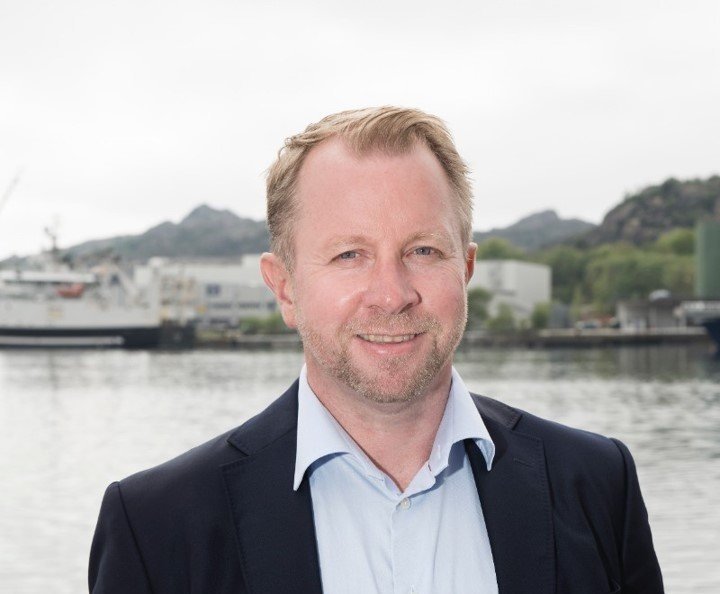Cluster Catch-up: HyFuel
“Together with our partners we ensure a circular industrial symbiosis, and motivation to increase the utilization of all the added resources. ”
In the last Cluster Catch-up, we had a chat with CCB Energy Holding and how they work on becoming one of the first actors to commercially produce hydrogen in Norway. This time it is HyFuel’s turn.
HyFuel AS is a joint venture between INC Invest, Sogn og Fjordane Energy and Gasnor. The goal is to produce sustainable green hydrogen at Fjord Base. They will develop, own, and operate a plant for producing hydrogen and hydrogenation of Liquid Organic Hydrogen Carrier (LOHC). Vegard Lavik is the project manager in HyFuel.
What is HyFuel’s primary focus right now?
Vegard Lavik, Project Manager, HyFuel
Our primary focus currently is to secure governmental funding for our hydrogen production plant. This is a crucial step towards being able to deliver hydrogen to the maritime market, and necessary to develop a sustainable market for hydrogen as a maritime fuel. The risks associated with being first timers in an immature market needs to be reduced by incentives and governmental grants are therefore essential to compensate until the market is fully developed.
HyFuel applied for funding through Enova’s program “Hydrogen for maritime transport” in April. Our short-term plans (> 3 years) are to produce compressed hydrogen (CH2) for the maritime industry. CH2 as a maritime fuel, is considered the most mature and the technology is ready to be implemented as zero-emission fuel on ships. The production facility will be scalable as the market matures. Long-term (3-5 years) we have plans for upscaling of production and installation of a LOHC hydrogenation plant. LOHC has several ideal physical properties such as being non-explosive, less flammable than MGO or diesel, and it can be stored under atmospheric conditions. This makes it possible to use conventional storage and transport technology and use existing infrastructure (such as how diesel is distributed today). Compared to stored hydrogen in gas or liquid form, LOHC provides a significant reduction of free hydrogen on board the vessel. The results are lower risk and potential cost reductions. Together with the equipment manufacturer, Hydrogenious LOHC Technologies, we are conceptualizing the next step of our project – being able to deliver LOHC to maritime customers.
What are the biggest challenges and opportunities for HyFuel in the future?
HyFuel’s hydrogen production plant will be located at Fjord Base in Florø. Fjord Base is Norway’s largest supply base in area with over 2000 port calls each year. The location is also in close proximity to Florø harbour which has over 3000 port calls yearly. This lays the foundation for HyFuel to be established as a central hydrogen hub along the western coast of Norway.
HyFuel has all the necessary prerequisites and facilities needed for production of hydrogen in a cost-efficient and safe way, such as available area (for current and future expansion plans), close proximity to end-users of biproducts (oxygen and heat) and large amounts of power. HyFuel has three solid owners, with complementary competence in the future value chain for hydrogen, creating a unique partnership and competitive business model.
The challenges lie in the lack of incentives throughout the industry. The entire value chain is requesting increased CO2 tax and differential contracts to enable a shift from fossil fuels to hydrogen. New zero emission technology will unavoidably be more expensive than existing solutions in a transitional period. Incentives are therefore needed to provide the much-needed push in a new direction. Without them, the industry seems to be stuck in a stand-still.
How can hydrogen be a part of the solution for the future?
Availability of hydrogen will undoubtedly be very important in the future if the maritime sector is to reach the predetermined goals for reduction of CO2 emission. Hydrogen also has a large potential to reduce greenhouse gas emissions from industrial processes as well as securing uninterrupted power supply needs. The state of the hydrogen will likely vary from one use case to another, depending on energy requirements – whether it be compressed, liquified, LOHC or ammonia. The future maritime port will most likely have to offer a variety of different zero emission fuels to accommodate the green shift.
What is your primary focus when it comes to sustainability?
Our concept is to produce green hydrogen based on renewable energy and electrolysis. In general, the efficiency for electrolysis is considered to be about 70%, and most of the energy loss is converted to excess heat.
HyFuel will develop solutions for utilizing the oxygen and excess heat in land-based fish farming together with our partners Havlandet Havbruk. Aiming to optimize the overall system efficiency in the design and operation of the plant. Hence, together with our partners we ensure a circular industrial symbiosis, and motivation to increase the utilization of all the added resources.
Why did you decide on becoming a member of Ocean Hyway Cluster?
Our owners have worked with the concept of hydrogen to zero emission fast ferries since 2016; when hydrogen powered fast ferry (GKP7H2) was initiated as part of DNV GL Green Shipping Program and lead by Ocean Hyway Cluster.
We believe that in order to succeed in a new and emerging market, it is crucial to work together with other parties in the value chain. Ocean Hyway Cluster creates a unique platform to harvest knowledge, network and increase visibility. It was therefore very important for HyFuel to become a member of Ocean Hyway Cluster after HyFuel as a joint venture was established in 2020.
More Cluster Catch-up
Maria Benæs Hunvik
Communications Advisor
+47 954 57 606
maria.hunvik(a)hubforocean.no







